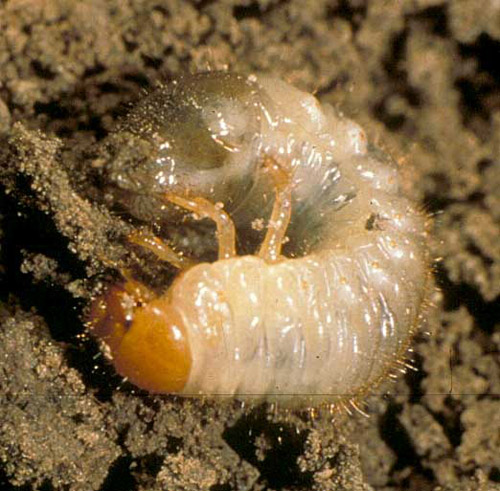Issue 11, July 2, 2012
White Grubs
We are set up to have large numbers of white grubs in turf this year. Adult beetles of Japanese beetle and the two masked chafer species are numerous throughout most of the state. Corresponding hot, dry weather will concentrate egg-laying in irrigated turf, resulting in high numbers of white grubs.
For the third year in a row, Japanese beetle adults are relatively few in central Illinois east of Mahomet. This phenomenon extends across central Indiana and central Ohio. Although weather conditions have been conducive to high numbers of beetles, they have not appeared. It is thought that there may be an undiscovered disease reducing population numbers. Inspections of various life stages have not revealed increased incidence of known parasite infestation or disease infection.

White grub larva.
Adult Japanese beetles and masked chafers appear to be attracted to green, healthy grass to lay their eggs. All three species tunnel into the soil to lay their eggs. Obviously, irrigated moist, soft soil is easier to dig into than unwatered, hot, dry soil. Research on southern masked chafer eggs has determined that they do not hatch at soil temperatures above 87 degrees F with soil moisture of 12.2% or below. As the soil temperature increases, the required soil moisture for hatch increases. In comparison, at 87 degrees F soil temperature and 18% moisture, over 70% of eggs hatch. The resulting white grubs survive better under moister soil. In hot, dry soil at 93 degrees F and 13.3% soil moisture, only 1.7% of southern masked chafer grubs survive. In hot, moist soil at 85.6 degrees F but 22.4% moisture, 56.7% of the grubs survive. These are additional reasons why adult beetles avoid dry soil when laying eggs.
Application of a long-lasting white grub insecticide is recommended during July to irrigated turf in areas where beetles are numerous. This includes chlorantroniliprole (Acelepryn), clothianidin (Arena), imidacloprid (Merit), or thiamethoxam (Meridian). In recent years, we have also recommended halofenozide (Mach 2) for this application. However, widespread failures of this product across the U.S. have been reported, possibly due to microbial degradation. In microbial degradation, microbes adapt to eat the pesticide. If you have had good results with Mach 2 in the past, feel free to continue using it but rotation with at least one other of the above insecticides on a yearly basis is recommended. (Phil Nixon)
Author:
Phil Nixon